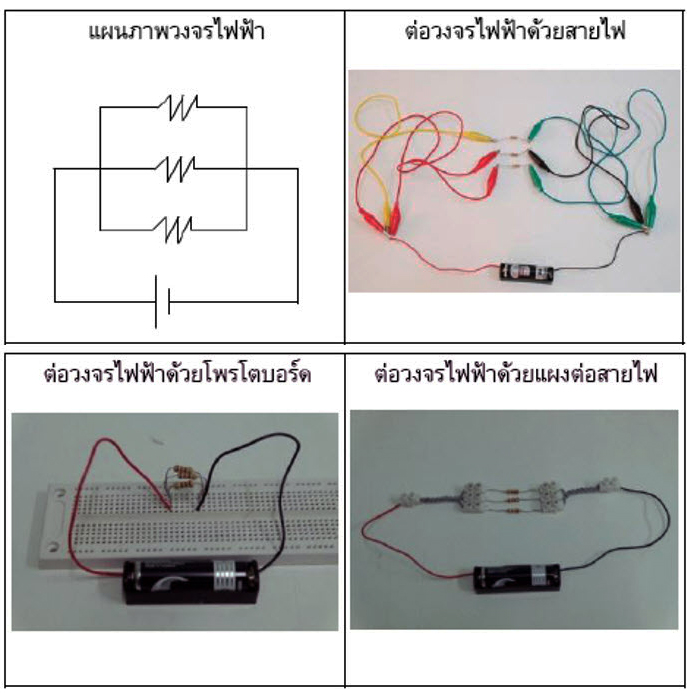การจัดการเรียนรู้แบบทำนาย–สังเกต–อธิบายเพื่อยกระดับความเข้าใจแนวคิดวิทยาศาสตร์เรื่อง วงจรไฟฟ้ากระแสตรงอย่างง่าย ของนักเรียนชั้นมัธยมศึกษาปีที่ 5
Main Article Content
Abstract
Phusit Juntana and Sura Wuttiprom
รับบทความ: 18 เมษายน 2558; ยอมรับตีพิมพ์: 5 มิถุนายน 2558
บทคัดย่อ
การวิจัยนี้มีวัตถุประสงค์เพื่อเปรียบเทียบแนวคิดวิทยาศาสตร์เรื่องวงจรไฟฟ้ากระแสตรงอย่างง่ายก่อนและหลังการจัดการเรียนรู้แบบทำนาย–สังเกต–อธิบายร่วมกับชุดการทดลองการต่อวงจรจากแผนภาพวงจร งานวิจัยนี้ใช้แผงต่อสายไฟแทนโพรโตบอร์ด กลุ่มที่ศึกษา คือ นักเรียนชั้นมัธยมศึกษาปีที่ 5 ภาคเรียนที่ 2 ปีการศึกษา 2557 โรงเรียนเลยพิทยาคม อำเภอเมืองเลย จังหวัดเลย ที่ชักตัวอย่างแบบเจาะจง จำนวน 30 คน เครื่องมือที่ใช้ในการวิจัย ได้แก่ ชุดการทดลอง แผนการจัดการเรียนรู้โดยใช้เทคนิคทำนาย–สังเกต–อธิบาย (POE) และแบบทดสอบความเข้าใจแนวคิดวิทยาศาสตร์เรื่องไฟฟ้ากระแสตรง ฉบับ 1.0 (DIRECT 1.0) วิเคราะห์ข้อมูลโดยการทดสอบที (t-test) และ normalized gain ผลการวิจัยพบว่า นักเรียนมีความเข้าใจแนวคิดวิทยาศาสตร์หลังเรียนสูงกว่าก่อนเรียนอย่างมีนัยสำคัญทางสถิติที่ระดับ .01 และมีความก้าวหน้าทางการเรียนรายชั้นเฉลี่ยระดับ medium gain (<g> = 0.35) ผลการวิจัยแสดงให้เห็นว่า การจัดการเรียนรู้แบบทำนาย–สังเกต–อธิบายสามารถใช้ในการพัฒนาความเข้าใจแนวคิดวิทยาศาสตร์ของนักเรียนได้
คำสำคัญ: แผงต่อสายไฟ โพรโตบอร์ด แนวคิดวิทยาศาสตร์ วงจรไฟฟ้ากระแสตรงอย่างง่าย การทำนาย–สังเกต–อธิบาย
Abstract
The purpose of this research was to compare the students’ scientific concept about simple direct current circuits before and after participating with predict–observe–explain teaching method incorporated with the experimental set involved in the building circuits from schematic drawings. This study used a terminal block as a protoboard. The sample group by purposive sampling is 30–Grade 11 students in the second semester of the academic year 2014 at Loeipittayakom School, Muangloei, Loei. The research tools consisted of an experimental set, lesson plans using the predict–observe–explain teaching method, and the Interpreting Resistive Electric Circuit Concepts Test (DIRECT 1.0). Data were analyzed by t–test and normalized gain. The results showed that the post–test mean score was significantly higher than the pre–test mean score at a statistical level of .01. The average class normalized gain was at the medium gain level (<g> = 0.35). The study illustrated that using predict-observe-explain teaching method can be used to develop students’ concepts.
Keywords: Terminal block, Protoboard, Scientific concepts, Simple direct current circuits, Predict–observe–explain
Downloads
Article Details

This work is licensed under a Creative Commons Attribution-NonCommercial 4.0 International License.
References
ไชยพงษ์ เรืองสุวรรณ. (2558). การจัดการเรียนการสอนแบบ POE. เข้าถึงได้จาก https:// www.gotoknow.org/posts/466145,สืบค้นวันที่ 27 พฤษภาคม 2558.
นัชชา แดงงาม และสุระ วุฒิพรหม. (2557). ผลการเรียนรู้แบบทำนาย–สังเกต–อธิบายร่วมกับการสาธิตอย่างง่ายต่อความคิดรวบยอดเรื่องการเคลื่อนที่แบบหมุน. วารสารหน่วยวิจัยวิทยาศาสตร์ เทคโนโลยี และสิ่งแวดล้อมเพื่อการเรียนรู้ 5(1): 86–93.
พัดตาวัน นาใจแก้ว และวรัญญา จีระวิพูลวรรณ (2557). การใช้การเรียนรู้แบบสืบเสาะหาความ รู้เสริมด้วยวิธีการสอนแบบทำนาย–สังเกต–อธิบายและการเปรียบเทียบแบบอุปมาอุปไมยต่อมโนมติเรื่องวงจรไฟฟ้ากระแสตรงของครูวิทยาศาสตร์ระดับประถมศึกษา. วารสารหน่วยวิจัยวิทยาศาสตร์ เทคโนโลยี และสิ่งแวดล้อมเพื่อการเรียนรู้ 5(1): 1–10.
ศราวุธ นาเสงี่ยม. (2554). การสอนแบบทำนาย สังเกต อธิบาย เพื่อความเข้าใจแนวคิด เรื่องวงจรไฟฟ้ากระแสตรง. วิทยานิพนธ์ปริญญาวิทยาศาสตรมหาบัณฑิต สาขาวิทยาศาสตร์ศึกษา บัณฑิตวิทยาลัย. อุบลราชธานี: มหาวิทยาลัยอุบลราชธานี.
อัศวรัฐ นามะกันคำ. (2550). การเปรียบเทียบความเข้าใจเชิงแนวคิดเรื่องวงจรไฟฟ้ากระแส ตรงของนักเรียนสายสามัญกับสายอาชีพ. วิทยานิพนธ์ปริญญาวิทยาศาสตรมหาบัณฑิต สาขาวิชาวิทยาศาสตร์ศึกษา บัณฑิตวิทยาลัย. เชียงใหม่: มหาวิทยาลัยเชียงใหม่.
Alparslan, C., Tekkaya, C., and Geban, O. (2003). Using the conceptual change instruction to improve learning. Journal of Biological Education 37(3): 133–137.
Confrey, J. (1990). A review of the research on student conceptions in mathematics, science and programming. Review of Research in Education 16: 3–56.
Davis, B. G. (1997). Misconceptions as barriers to understanding science. In B. G. Davis (Ed.), Science Teaching Reconsidered: A Hand Book (pp. 27–32), Washington, DC: National Academy.
diSessa, A. A. (1998). What changes in conceptual change? International Journal of Science Education. 20(10): 1155–1191.
Engelhardt, P. V., and Beichner, R. J. (1997). Examining students’ understanding of electrical circuits through multiple–choice testing and interviews, Unpublished Doctoral Dissertation. North Carolina State University.
Hake, R. R. (1998). Interactive–engagement vs traditional methods: A six–thousand–student survey of mechanics test data for introductory physics courses. American Journal of Physics 61(1): 64–74.
Haysom, J., and Bowen, M. (2010). Predict, Observe, Explain: Activities Enhancing Scientific Understanding. USA: National Science Teachers Association.
McDermott, L. C., and Shaffer, P. S. (1992). Research as a guide for curriculum: An example from introductory electricity. Part I: Investigation of student understanding. American Journal of Physics 60(11): 994–1002.
Muller, D. A., Sharma, M. D., Eklund, J., and Reimann, P. (2007). Conceptual change through vicarious learning in an authentic physics setting. Instructional Science 35(6): 519–533.
Planinic, M., Boone, W. J., Krsnik, R., and Beilfuss, M. L. (2006). Exploring alternative concepts from Newtonian dynamics and simple DC circuits: Links between item difficulty and item confidence. Journal of Research in Science Teaching 43(2): 150–171.
Thacker, B., Kim, E., and Trefz, K. (1994). Comparing problem solving performance of physics students in inquiry-based and traditional introductory physics courses. American Journal of Physics 62(7): 627–633.
White, R., and Gunstone, R. (1992). Probing Understanding. London: The Falmer.
